
Fortran is a third generation, compiled, imperative programming language that is especially suited to numeric computation and scientific computing.

The IBM 704 is a large digital mainframe computer introduced by IBM in 1954. It was the first mass-produced computer with hardware for floating-point arithmetic. The IBM 704 Manual of operation states:
The type 704 Electronic Data-Processing Machine is a large-scale, high-speed electronic calculator controlled by an internally stored program of the single address type.

The IBM 1620 was announced by IBM on October 21, 1959, and marketed as an inexpensive scientific computer. After a total production of about two thousand machines, it was withdrawn on November 19, 1970. Modified versions of the 1620 were used as the CPU of the IBM 1710 and IBM 1720 Industrial Process Control Systems.

The IBM 650 Magnetic Drum Data-Processing Machine is an early digital computer produced by IBM in the mid-1950s. It was the first mass produced computer in the world. Almost 2,000 systems were produced, the last in 1962, and it was the first computer to make a meaningful profit. The first one was installed in late 1954 and it was the most-popular computer of the 1950s.

The IBM 7090 is a second-generation transistorized version of the earlier IBM 709 vacuum tube mainframe computer that was designed for "large-scale scientific and technological applications". The 7090 is the fourth member of the IBM 700/7000 series scientific computers. The first 7090 installation was in December 1959. In 1960, a typical system sold for $2.9 million or could be rented for $63,500 a month.

The IBM 700/7000 series is a series of large-scale (mainframe) computer systems that were made by IBM through the 1950s and early 1960s. The series includes several different, incompatible processor architectures. The 700s use vacuum-tube logic and were made obsolete by the introduction of the transistorized 7000s. The 7000s, in turn, were eventually replaced with System/360, which was announced in 1964. However the 360/65, the first 360 powerful enough to replace 7000s, did not become available until November 1965. Early problems with OS/360 and the high cost of converting software kept many 7000s in service for years afterward.
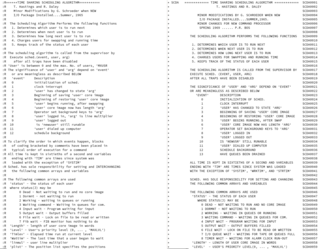
The Compatible Time-Sharing System (CTSS) was the first general purpose time-sharing operating system. Compatible Time Sharing referred to time sharing which was compatible with batch processing; it could offer both time sharing and batch processing concurrently.
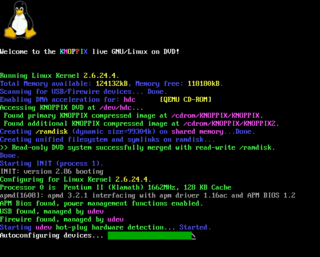
One meaning of system console, computer console, root console, operator's console, or simply console is the text entry and display device for system administration messages, particularly those from the BIOS or boot loader, the kernel, from the init system and from the system logger. It is a physical device consisting of a keyboard and a printer or screen, and traditionally is a text terminal, but may also be a graphical terminal. System consoles are generalized to computer terminals, which are abstracted respectively by virtual consoles and terminal emulators. Today communication with system consoles is generally done abstractly, via the standard streams, but there may be system-specific interfaces, for example those used by the system kernel.
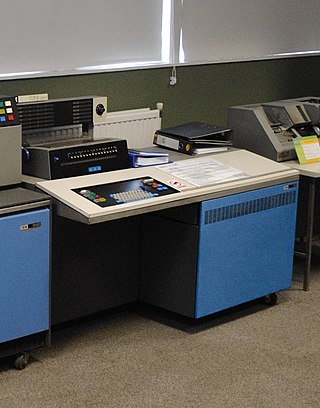
The IBM 1130 Computing System, introduced in 1965, was IBM's least expensive computer at that time. A binary 16-bit machine, it was marketed to price-sensitive, computing-intensive technical markets, like education and engineering, succeeding the decimal IBM 1620 in that market segment. Typical installations included a 1 megabyte disk drive that stored the operating system, compilers and object programs, with program source generated and maintained on punched cards. Fortran was the most common programming language used, but several others, including APL, were available.
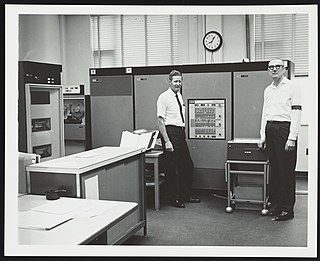
The IBM 1800 Data Acquisition and Control System (DACS) was a process control variant of the IBM 1130 with two extra instructions, extra I/O capabilities, 'selector channel like' cycle-stealing capability and three hardware index registers.
In computing, a line number is a method used to specify a particular sequence of characters in a text file. The most common method of assigning numbers to lines is to assign every line a unique number, starting at 1 for the first line, and incrementing by 1 for each successive line.

The IBM 2250 Graphics Display Unit was a vector graphics display system by IBM for the System/360; the Model IV attached to the IBM 1130.

A front panel was used on early electronic computers to display and allow the alteration of the state of the machine's internal registers and memory. The front panel usually consisted of arrays of indicator lamps, digit and symbol displays, toggle switches, dials, and push buttons mounted on a sheet metal face plate. In early machines, CRTs might also be present. Prior to the development of CRT system consoles, many computers such as the IBM 1620 had console typewriters.
A computer operator is a role in IT which oversees the running of computer systems, ensuring that the machines, and computers are running properly. The job of a computer operator as defined by the United States Bureau of Labor Statistics is to "monitor and control ... and respond to ... enter commands ... set controls on computer and peripheral devices. This Excludes Data Entry."
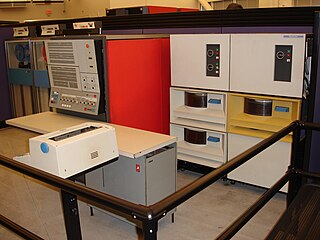
The IBM System/360 Model 30 was a low-end member of the IBM System/360 family. It was announced on April 7, 1964, shipped in 1965, and withdrawn on October 7, 1977. The Model 30 was designed by IBM's General Systems Division in Endicott, New York, and manufactured in Endicott and other IBM manufacturing sites outside of U.S.

From the invention of computer programming languages up to the mid-1970s, most computer programmers created, edited and stored their programs line by line on punch cards.

The NCR Century 100 was NCR's first all integrated circuit computer built in 1968. All logic gates were created by wire-wrapping NAND gates together to form flip-flops and other complex circuits. The console of the system had only 18 lights and switches and allowed entry of a boot routine, or changes to loaded programs or data in memory. A typewriter console was also available.

The IBM 711 was a punched card reader used as a peripheral device for IBM mainframe vacuum tube computers and early transistorized computers. Announced on May 21, 1952, it was first shipped with the IBM 701. Later IBM computers that used it were the IBM 704, the IBM 709, and the transistorized IBM 7090 and 7094.

The IBM 1443 Printer is an obsolete computer line printer used in the punched card era. It was offered in three models: Models 1, 2 and N1; the last two could print up to 240 lines per minute (LPM) with a full character set.
















